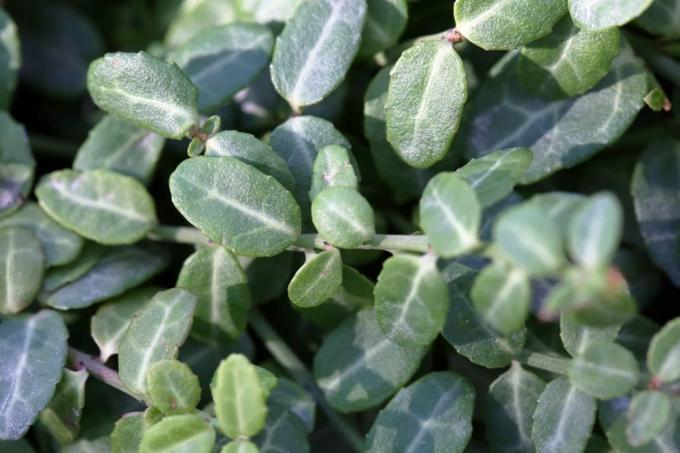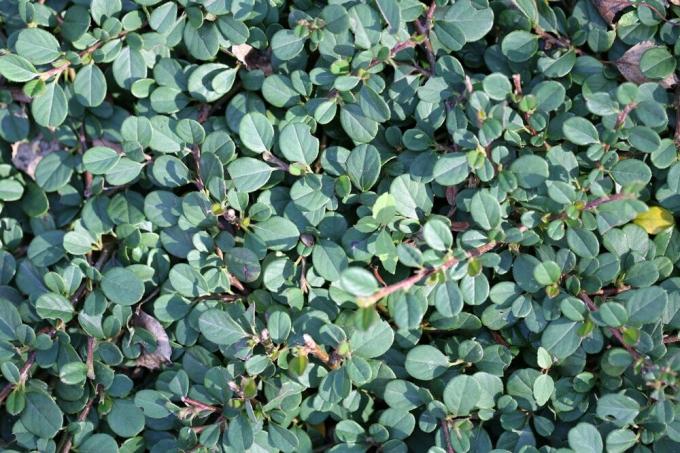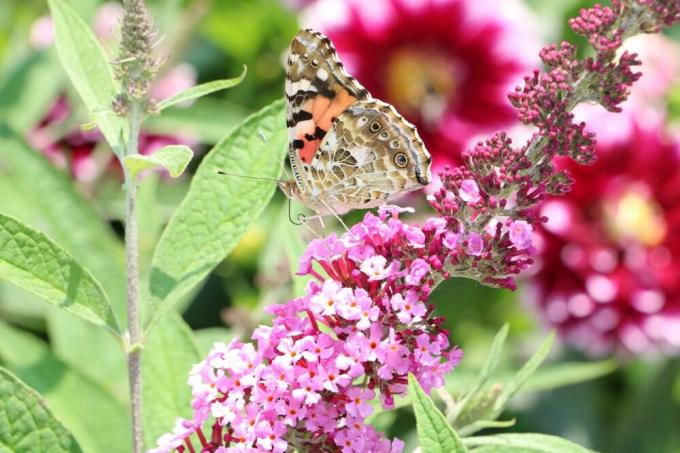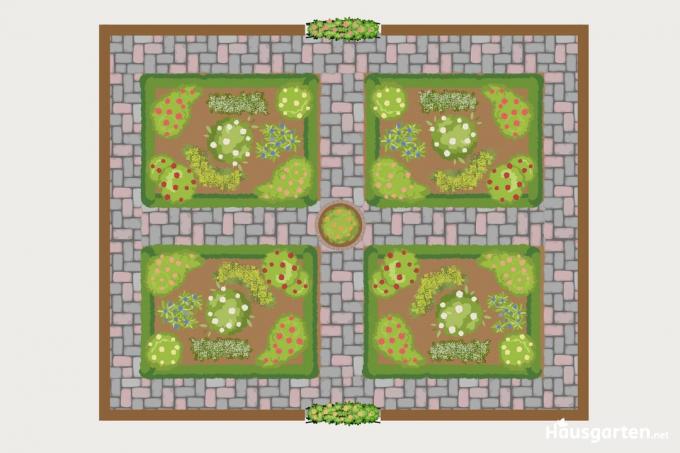

Table of contents
- Which plants are suitable for planting on slopes?
- ground cover
- Spindle bush
- bushbill
- Carpet St. John's Wort
- cotoneaster
- shrubs and shrubs
- Buddleia
- liguster
- cinquefoil
- ornamental quince
- creeping juniper
- cornel
- wildflowers
- kidney vetch
- Carthusian carnation
- Cypress Spurge
- Real bedstraw
- ornamental grasses
- Japanese blood grass
- blue fescue
- mosquito grass
- Conclusion
The slope planting should be well thought out, because the steep location often entails additional challenges in gardening. But with the right selection of the right plants for this demanding location, every slope can be made into an eye-catcher. This article provides an overview of the most popular plants for growing on a sunny slope!
Which plants are suitable for planting on slopes?
The steep slopes usually mean that unpaved soil is washed away by the rain. In addition, the soil is usually very dry, since rainwater seeps away only with difficulty. Likewise, the amount of work is usually increased in a steep location, which is why permanent greening is advisable. When choosing plants, keep the following in mind:
- Plants with a pronounced root system
- these form well branched and strong roots
- which can hold the ground
- Robust and vigorous plants are also ideal
Tip:
Plants with shallow roots should not be cultivated on slopes. Because the risk of a landslide is too high. Likewise, plants that tend to become invasive should not be grown on slopes.
ground cover
So-called ground covers are usually characterized by dense foliage and a decorative carpet of flowers. They form many runners and strong roots on the shoots and thus hold the ground like a net. In addition, the ground cover suppresses weeds and protects against erosion. The most popular ground covers include:
Spindle bush

The spindle shrub is suitable for sunny to semi-shady locations and can easily be grown on slopes. Around 170 species of this plant are known, with the "Minimus" variety being particularly suitable as a ground cover. The spindle shrub does not tolerate waterlogging, which is why well-drained soil is essential for cultivation. The spindle bush is characterized by the following characteristics:
- Latin name: Euonymus fortunei
- Synonyms: creeping spindle, spindle bush, climbing spindle
- Growth height: up to 3 m
- Foliage: green-white to green-yellow
- flowers: white to pale green
- Fruits: pink to red capsule fruits
bushbill
The cranesbill impresses with its diversity of varieties, because there are around 400 different varieties. It is also extremely easy to care for and usually tolerates drought better than waterlogging. Therefore, the shrub beak is ideal for growing on a sunny slope. In addition to its strongly aromatic-scented foliage, it also has the following characteristics:
- Latin name: geranium
- Synonyms: Crane's beak, beak herb
- Growth height: 15 to 100 cm
- Foliage: green, yellow or red autumn colour
- Flowers: cupped, white, pink, violet, blue or crimson
- Fruits: split fruit
Carpet St. John's Wort
The carpet St. John's wort prefers a humus-rich and nutrient-rich soil. Cultivation can be done both on a sunny and on a shady slope. The plant is annual and perennial and also very hardy. The carpet St. John's wort is also characterized by the following properties:
- Latin name: Hypericum calycinum
- Growth height: up to 30 cm
- Foliage: dark green or evergreen, oblong
- flowers: cupped and golden yellow
cotoneaster

The cotoneaster spreads extremely quickly and suppresses any weeds. It is therefore ideal for securing embankments and slopes. The cotoneaster is frost hardy and tolerates pruning well and also has the following properties:
- Latin name: Cotoneaster praecox
- Growth height: 15 to 20 cm
- Foliage: shiny dark green
- flowers: white to pink
- Fruits: red apple fruits
shrubs and shrubs
The cultivation of shrubs and woody plants is ideal for slopes, as the plants are usually very easy to care for. With these plants, regular pruning is usually not necessary, which makes the necessary workload noticeably easier. The following shrubs and woody plants are suitable for growing on a sunny slope:
Buddleia

The summer lilac not only impresses with its decorative appearance, but also exudes a very pleasant scent. In addition, the plant magically attracts butterflies, which is why it is also known under the name "Butterfly Lilac". The deciduous shrub prefers a sunny position and can easily be grown on slopes:
- Latin name: Buddleja davidii
- Synonyms: butterfly bush, butterfly bush, lilac spear
- Growth height: 0.5 to 5 m
- Foliage: narrowly lanceolate, weakly toothed, dark green
- Flowers: many flower colors
- Fruits: capsule fruits
liguster

The privet is an evergreen hedge plant, which counts around 50 species. It is considered to be very adaptable and is not picky about the choice of soil. The plant tolerates drought without any problems, which is why the fast-growing plant is also ideal for planting on slopes in a sunny position. The privet also has the following attributes:
- Latin name: Ligustrum
- Synonyms: rain pasture
- Growth height: 2 to 5 m
- Foliage: evergreen
- Flowers: white panicles
- Fruits: poisonous berries or drupes
cinquefoil
The cinquefoil grows sprawling and bushy and thrives best in moderately moist soil. However, it does not tolerate drought, as it is sensitive to drought and can die off if it is dry for a long time. A location in full sun is ideal for this shrub that blooms for months. The cinquefoil is also characterized by the following features:
- Latin name: Dasiphora fruticosa or Potentilla fruticosa
- Synonyms: shrub cinquefoil
- Growth height: 50 to 150 cm
- Foliage: deciduous
- flowers: cupped, yellow, orange, pink, white, red
ornamental quince
The ornamental quince is not only a visual eye-catcher, but also provides fruit rich in vitamins. It applies from completely undemanding and does not need to be cut. When choosing soil, make sure that it is not too calcareous. The ornamental quince also has the following properties:
- Latin name: Chaenomeles
- Growth height: up to 1.5 m
- Foliage: deciduous
- flowers: cupped, red, pink, white or orange
- Fruits: mini quinces
creeping juniper
The creeping juniper is considered a particularly easy-care lawn substitute. It has no special demands on the floor and is also very robust and heat-resistant. Since it grows very slowly, pruning is not necessary. Creeping Juniper also has the following attributes:
- Latin name: Juniperus horizontalis
- Synonyms: carpet juniper
- Growth height: up to 20 cm
- Foliage: very dense and pillowy, steel blue, evergreen
- Fruits: small, blue colored berry cones
cornel

The slow-growing cornel is a robust, classic garden tree. Although it is considered quite undemanding, it does not tolerate waterlogging. When choosing the soil, make sure that it is moist, calcareous and rich in nutrients. However, the Cornus also tolerates slightly acidic soils without any problems and also has the following properties:
- Latin name: Cornus mas
- Synonyms: Herlitze, yellow dogwood
- Growth height: up to 8 m as a tree
- Foliage: green, shiny underside
- flowers: yellow
- Fruits: red, cherry-like fruits
wildflowers
Planting wildflowers is particularly popular due to the low maintenance and decorative appearance. However, they are usually not suitable for growing on very steep slopes, as they should be mowed at least once a year. Some of the most popular wildflowers include:
kidney vetch
The kidney vetch thrives ideally in sunny locations and prefers a calcareous and dry soil. The flower is not only a visual eye-catcher, but is also considered a medicinal plant. In addition, kidney vetch has the following properties:
- Latin name: Anthyllis vulneraria
- Synonyms: real kidney vetch, common kidney vetch, common kidney vetch
- Growth height: 5 to 40 cm
- leaves: imparipinnate
- Flowers: yellow with reddish tips
Carthusian carnation
The Carthusian Pink prefers a well-drained, sandy soil in full sun and a dry spot. It is considered a biennial plant and has good frost hardiness. The clove also has the following properties:
- Latin name: Dianthus carthusianorum
- Synonyms: stone carnation, stone algae
- Growth height: 10 to 60 cm
- Leaves: dark green, grassy and acuminate
- flowers: crimson
Cypress Spurge

Although the cypress spurge is poisonous, it is also considered a medicinal plant. It prefers a dry and well-drained soil. Although the plant spreads a lot, it is not necessary to cut it back. The cypress spurge also has the following attributes:
- Latin name: Euphorbia cyparissias
- Growth height: 15 to 30 cm
- Leaves: blue-green to yellow-green
- Flowers: lemon yellow
Real bedstraw
The true bedstraw is a bright yellow wildflower whose flowers exude an intense honey smell. The bedstraw prefers a dry location and forms long and strongly branched roots. In addition, the real bedstraw has the following characteristics:
- Latin name: Galium verum
- Synonyms: yellow forest straw, sweetheart, limb herb, lady's bed straw
- Growth height: 20 to 70 cm
- Leaves: acicular and furrowed
- flowers: golden to lemon yellow
ornamental grasses
The cultivation of ornamental grasses is particularly suitable on dry soils, which are located south or west. They are considered to be easy to care for and are therefore particularly suitable for planting on steep slopes. The most popular ornamental grasses include:
Japanese blood grass
The Japanese blood grass is extremely warmth-loving and therefore thrives best in sunny locations. When choosing soil, make sure that it is humus and permeable. The Japanese blood grass is considered easy to care for and has the following characteristics:
- Latin name: Imperata cylindrica
- Synonyms: silver hair grass
- Growth height: 30 to 40 cm
- Colouring: bright red
blue fescue

The blue fescue is considered extremely undemanding and can easily be grown on dry soil. It is also very easy to care for, as it does not need to be mowed or trimmed. The blue fescue also has the following properties:
- Latin name: Festuca cinerea
- Synonyms: bearskin grass
- Growth height: 20 to 30 cm
- Colouring: blue-grey
mosquito grass
The mosquito grass prefers dry and sunny locations. It also thrives best on well-drained and calcareous soils. It also impresses with its unique appearance, because its flowers resemble well-known insects. Mosquito grass also has the following properties:
- Latin name: Bouteloua gracilis
- Growth height: 20 to 40 cm
- Colouring: blue-green
Conclusion
Sunny slopes can be embellished with a variety of plants. An interplay of different plant species, such as wild flowers, ground cover and shrubs, is ideal. Many of these plants are also considered to be robust and easy to care for, which reduces the amount of work required to a minimum.
 garden editorial
garden editorial I write about everything that interests me in my garden.
Learn more about garden design

Intercept the embankment with formwork blocks
Supporting an embankment with formwork blocks is a stable and durable solution. However, there are a few points that are important when setting up, which must be observed to ensure a high level of safety. These include, for example, the correct procedure for laying the foundation.

Fill gabions: stones, wire thickness & sizes
Because of their properties, gabions are among the most popular fence and wall alternatives. Selecting the right size and gauge of wire is essential for a successful installation, so that they can be filled without any problems and do not bulge or bulge under the weight of the stones fall over.

Label stones weatherproof - this is how it works on stone + slate
In itself, marking slate and stones weatherproof is quite easy if you have the right knowledge and the right tools. Here we tell you how it works and what is required for it.

6 ideas for designing rose beds - planting plan & ideas for rose beds
Is it high time that your garden was kissed awake by the queen of flowers? Then let yourself be inspired by 6 ideas for an imaginative design of rose beds. Sturdy planting plans demonstrate in detail how to stylishly turn romantic blooming dreams into reality.

Create a snack garden in the garden and on the balcony
A snack garden finds space in the smallest garden. Even balconies and terraces offer space for a few selected plants, from which fruits can be nibbled, not only by children. Important here are the location and a suitable plant substrate.
Planting on the property line – what needs to be considered?
Finally own property or for rent with adjoining garden - many immediately dream of a lush variety of plants. But even those who want to set hedges or shrubs as privacy screens should not immediately start planting. Because not only at the immediate property line there are a few things to consider.
